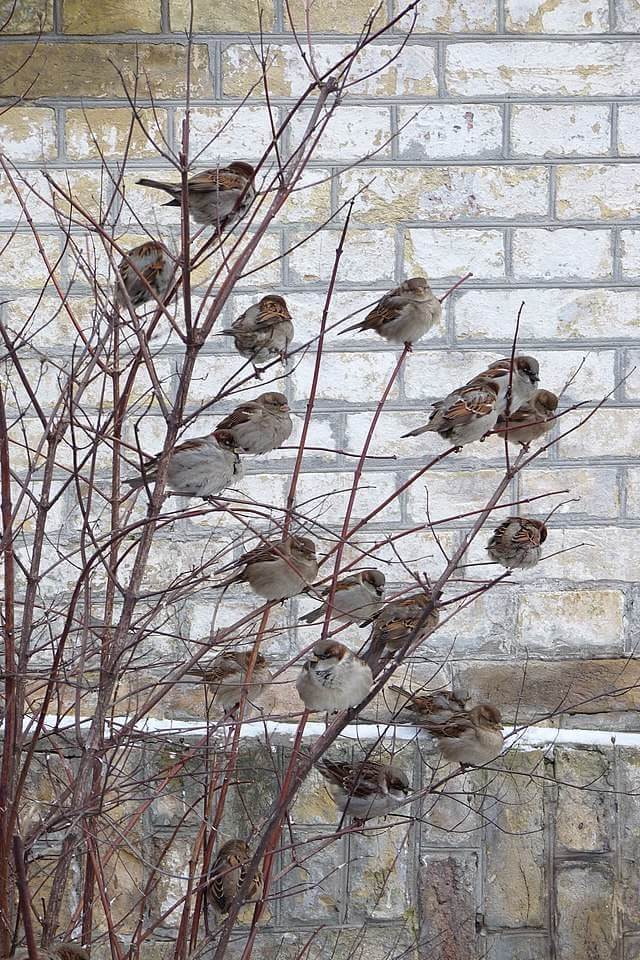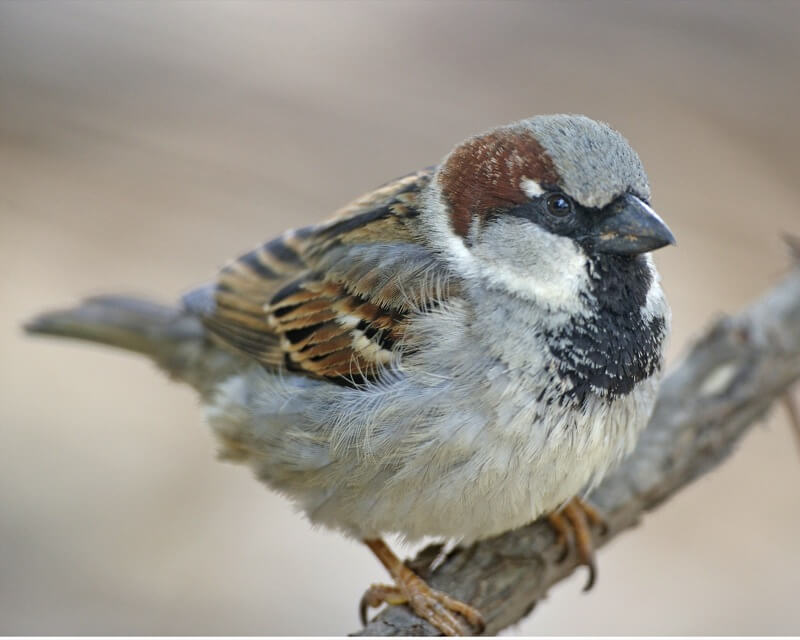The Wonderful World of the House Sparrow
By Pam Carlton
Broadcast 3.2022 and 3.13 & 3.16.2024

House sparrows flocking in a shrub. Photo by AwOiSoAk KaOsIoWa, CC 2.0.
Listen:
Whenever you walk out your door into your yard, alley, or front stoop you will likely see them: little brown birds in raucous groups of up to 200 individuals. Many see them as pests and because they are small, brown, nondescript, and everywhere they are often overlooked. They are House Sparrows (Passer domesticus).
For the longest time I lamented the fact that the only birds I saw in my yard were these sparrows. Then I took the time to sit and watch and see what exactly was going on in my own backyard. Yes, House Sparrows are everywhere, and yes, they are raucous, but they are surprisingly interesting once you take the time to pay attention. I noticed last year that a sparrow had made a nest in a hole in the soffit of my house, and a sparrow appears to have a nest there again this year. Is it the same sparrow? I began to wonder if—and how—groups of sparrows maintain structure.
House Sparrows are not native to the United States. They were introduced from Europe in 1850. Nicholas Pike, Director of the Brooklyn Institute, purchased eight pairs of sparrows from Liverpool, England. They were released in 1851, but none of them survived. Later that year, he purchased 25 more and over-wintered them at the Institute. These birds were then released into the parks of New York City and began to thrive. But House Sparrows did not spread across the United States without help. More were released in various parts of the U.S. over the next twenty-five years. Although their numbers did not explode immediately, they eventually came to inhabit every state in the Union.
House Sparrows have many of the key characteristics needed for a successful invasion. They can easily establish themselves in a variety of environments. They live in grasslands, forests, and urban areas. They also reproduce, and grow, rapidly. House Sparrows can raise up to five clutches of two to seven chicks a season. Finally, they are aggressive competitors, nesting much earlier in the spring than many other birds.
House Sparrows mate for life, although they will show promiscuous behavior outside of the mate-bond. They live in colonies of up to 40 birds, and once they have been accepted by a colony and claim a nest site, which they return to each year, they are set for life. The sparrow will remain in that colony and will never be banished.
One of the more interesting facts about these little brown birds is that much of their success stems from the military precision with which they arrange their groups. Because House Sparrows are very social creatures, without some sort of structure they would spend their time fighting among themselves—thus not being nearly as successful as they are. Leaders of other groups that live in close social arrangements have some identifying feature that announces to the others that they are in charge, such as the silverback in mountain gorilla families, or the size of the antlers in elk and deer.

Male House Sparrow – note black breast patch. Photo by Lip Kee, CC 2.0.
For the House Sparrow it is the size of the male’s black breast patch. Males with the largest breast patch are highest in the pecking order. All of the sparrows know where they fall in this pecking order and the highest-ranking individual gets the safest feeding spots, has the largest breeding territory with more and better mates, and is first in line for food when food is scarce. Scientists are not sure what makes the breast patches bigger on some than on others, but they have found a positive correlation between the fighting ability of the male and the size of the patch.
So the next time you walk out your front door, take a minute to watch the ubiquitous House Sparrow. Instead of calling it a menace, marvel at the intricate social structure that allows it to be so successful.
Every week since 1991, Field Notes has inquired about Montana’s natural history. Field Notes are written by naturalists, students, and listeners about the puzzle-tree bark, eagle talons, woolly aphids, and giant puffballs of Western, Central and Southwestern Montana and aired weekly on Montana Public Radio.
Click here to read and listen to more Field Notes. Field Notes is available as a podcast! Subscribe on Apple Podcasts or wherever you listen to podcasts.
Interested in writing a Field Note? Contact Allison De Jong, Field Notes editor, at adejong [at] montananaturalist [dot] org or 406.327.0405.
Want to learn more about our programs as well as fun natural history facts and seasonal phenology? Sign up for our e-newsletter! You can also become a member and get discounts on our programs as well as free reciprocal admission to 300+ science centers in North America!












